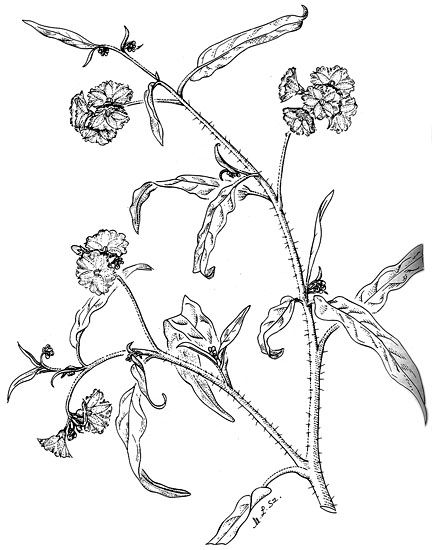
Synonymy
Solanum cunninghamii Benth., Fl. Austral. 4: 465 (1868)
T: Cygnet Bay, NW Coast, W.A., A. Cunningham 134; lecto: K; iso: BM, fide D.E. Symon, J. Adelaide Bot. Gard. 4: 291-292 (1981); NW Coast, Bynoe s.n.; syn: K; Glenelg district, Martin s.n.; syn: MEL. Images of isolectotype material can be seen on the Solanaceae Source site.
Description
Erect, clonal shrub to 2m, male or female, rusty-green, densely pubescent with stellate hairs; prickles 2-5 mm long, abundant on calyx-tube of bisexual flower, usually scattered on stems.
Leaves lanceolate-elliptic; lamina 3-7 cm long, 1-1.5 cm wide, sometimes larger, discolorous, entire; petiole 5-10 mm long.
Male plant: inflorescence up to 50-flowered; peduncle 20-30 mm long; rachis 10-15 cm long, pedicels 2-4 mm long; calyx 4-6 mm long, the lobes triangular, 2-4 mm long; corolla shallowly campanulate-rotate, 25-30 mm diam., purple-blue; anthers 3-4 mm long. Female plant: flowers solitary; pedicels 5-15 mm long, lengthened in fruit; calyx 9-14, sometimes to 20, mm long, enlarged in fruit, the lobes more or less linear, 5-7(-10) mm long; corolla rotate, 20-30 mm diam., purple; anthers 3-4 mm long.
Berry globular or depressed globular, 20 mm diam.; colour unknown; fruiting pedicels 15-20 mm long; fruiting calyx 25-30 mm diam. Seeds 2 mm long, dark brown. n=12.
Distribution and ecology
Occurs in near coastal areas near Broome, W.A., usually in deep red sandy soil in open woodland.
Relationships
All of the dioecious members of the Dioicum group of subgen. Leptostemonum exhibit functional dioecy i.e. male flowers are borne on separate plants from what appear to be plants with bisexual or hermaphrodite flowers; while these bisexual flowers do produce pollen, it is inaperturate and does not germinate, making the flowers effectively female (Knapp et al.,1998).
Initial molecular studies by Martine et al. (2006) suggested that the two functionally dioecious species from Kakadu, S. asymmetriphyllum and the newly described S. sejunctum, formed a separate clade and had arisen separately from the other dioecious members of the Dioicum group, S. cunninghamii, S. cataphractum , S. dioicum, S. petraeum, S. carduiforme, S. tudununggae, S. vansittartense and S. leopoldense. T his initial DNA analysis involved sequencing of the ITS region of nuclear rDNA.
However further molecular analysis involving the trnK-matK gene region indicated that all of the functionally dioecious species form a single clade arising from the andromononoecious species of the group (Martine et al., 2009).
Many of these dioecious species remain undercollected and poorly understood and it is likely that some of these names will be changed with further work. Three of the four collections of S. cunninghamii included in the initial DNA analysis (Martine et al, 2006) showed a close relationship to each other, but also to other species of the group, while the fourth specimen was quite removed from the other three S. cunninghamii specimens. This species was not part of the second analysis.
References: S.Knapp, V.Persson & S.Blackmore (1998). Pollen morphology and functional dioecy in Solanum (Solanaceae). Pl. Syst. Evol. 210:113-139.; Martine, C.T., D. Vanderpool, G.J. Anderson, and D.H. Les (2006). Phylogenetic relationships of andromonoecious and dioecious Australian species of Solanum subgenus Leptostemonum section Melongena: Inferences from ITS sequence data. Systematic Botany 31: 410-420; Martine, C.T., G.J. Anderson & D.H. Les (2006). Gender-bending aubergines; molecular phylogenetics of cryptically dioecious Solanum in Australia. Australian Systematic Botany 22: 107-120.
Notes
Germination studies for mine regeneration or the native food industry indicated that seed of this species did not require any pretreatments in order for germination to occur.
Reference: Commander LE, Merritt DJ, Rokich DP, Flematti GR & Dixon KW (2008). Seed germination of Solanum spp. (Solanaceae) for use in rehabilitation and commercial industries. Australian Journal of Botany 56, 333–341.
Derivation of epithet
Named for botanist Allan Cunningham (1791-1839), collector of the type specimen from the Kimberley region of W.A.
Selected specimens
W.A.: Broome, D.E. Symon 5342 (CANB, NSW), and 5345 (AD, CANB, NSW); Cable Bay, D.E. Symon 6999, 7000 (AD, PERTH).
Plant status, if any
Not considered to be at risk in WA.
From the web
Further information for S. cunninghamii in WA can be found on the FloraBase site.
Further information and links for this species can be found on the Solanaceae Source site


